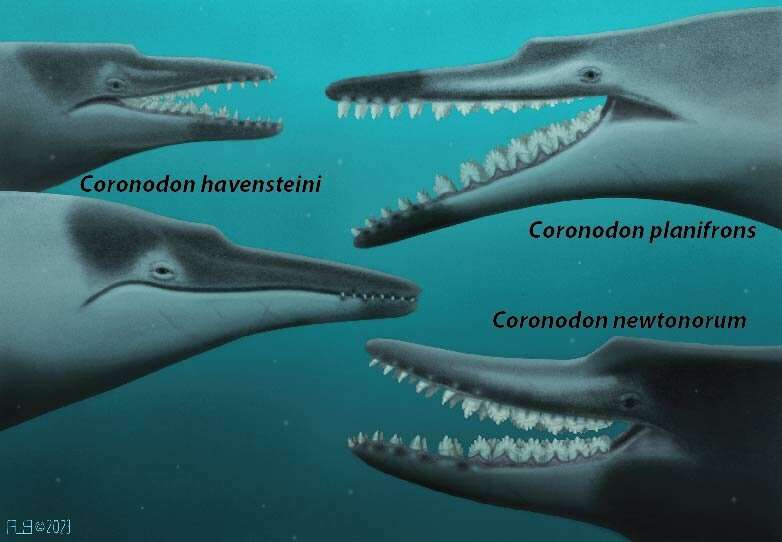This article has been reviewed according to Science X's editorial process and policies. Editors have highlighted the following attributes while ensuring the content's credibility:
fact-checked
peer-reviewed publication
proofread
New specimens and species of the Oligocene toothed baleen whale Coronodon

A new study published in the journal PeerJ by Robert W. Boessenecker (CofC), Brian L. Beatty (NYIT), and Jonathan H. Geisler (NYIT) reports a wealth of new fossils of the early toothed baleen whale Coronodon from Oligocene (23-30 million years old) rock layers near Charleston, South Carolina.
These include five new skulls, representing two new species: Coronodon planifrons and Coronodon newtonorum, and young juveniles of Coronodon havensteini—first named from a single skull by this team in 2017. Coronodon is one of the most primitive members of the group that includes living baleen whales—its name translate to "crown tooth" referring to the large, multi-cusped teeth that overlap in the mouth. An ongoing scientific controversy concerns whether these teeth were used for cutting, filter-feeding, or a combination of both.
The two new species, Coronodon planifrons and Coronodon newtonorum, are found in the same rock layer and date to the same time period (late Oligocene; 25-23 myo). Coronodon havensteini (30-28 myo) is older and is a possible ancestor of these two species. Coronodon planifrons is named after a skull with a flat 'forehead' and possibly an extra tooth relative to the other species.
Coronodon newtonorum is also known from a single skull and mandible, with slightly smaller teeth and an unusual shaped mouth that made it look like it was permanently 'smiling."
New specimens of Coronodon havensteini include an old adult and two calves, and providing a rare window into the early growth and development of an Oligocene whales. Unlike modern dolphins and baleen whales, the snout stays the same length during growth—rather than being shorter in juveniles. The early growth of the snout is probably related to its large teeth, and underscores how important the teeth are to understanding this early whale.
These new specimens and species indicate that Coronodon had a proportionally large head relative to its skeleton, swam in a style much like modern baleen whales, and likely had a flexible chin and joints in the skull that are typically associated with filter feeding. However, Coronodon appears to have lacked baleen. Reconstruction of the evolutionary tree of baleen whales places Coronodon as its earliest branch and this is key to understanding the transition from feeding with teeth to feeding with baleen.
More information: Robert W. Boessenecker et al, New specimens and species of the Oligocene toothed baleen whale Coronodon from South Carolina and the origin of Neoceti, PeerJ (2023). DOI: 10.7717/peerj.14795
Journal information: PeerJ
Provided by College of Charleston





















